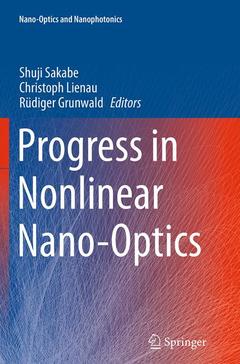Description
Progress in Nonlinear Nano-Optics, Softcover reprint of the original 1st ed. 2015
Nano-Optics and Nanophotonics Series
Coordinators: Sakabe Shuji, Lienau Christoph, Grunwald Rüdiger
Language: English
Subjects for Progress in Nonlinear Nano-Optics:
Progress in Nonlinear Nano-Optics
Publication date: 09-2016
Support: Print on demand
Publication date: 09-2016
Support: Print on demand
Progress in Nonlinear Nano-Optics
Publication date: 01-2015
273 p. · 15.5x23.5 cm · Hardback
Publication date: 01-2015
273 p. · 15.5x23.5 cm · Hardback
Description
/li>Contents
/li>Comment
/li>
This book presents the state of the art in nonlinear nanostructures for ultrafast laser applications. Most recent results in two emerging fields are presented: (i) generation of laser-induced nanostructures in materials like metals, metal oxides and semiconductors, and (ii) ultrafast excitation and energy transfer in nanoscale physical, chemical and hybrid systems. Particular emphasis is laid on the up-to-date controversially discussed mechanisms of sub-wavelength ripple formation including models of self-organized material transport and multiphoton excitation channels, nonlinear optics of plasmonic structures (nanotips, nanowires, 3D-metamaterials), and energy localization and transport on ultrafast time scale and spatial nanoscale. High-resolution spectroscopy, simulation and characterization techniques are reported. New applications of ultrashort-pulsed lasers for materials processing and the use of nanostructured materials for characterizing laser fields and laser-matter-interactions are discussed.
Laser-Induced Nanostructures.- Nanostructures Formation at Metal Surfaces.- General Aspects and Structuring in Three Dimensions.- Nanostructure Formation in Semiconductors and Dielectrics.- Nonlinear Nano-Optics.- Plasmonics, Metamaterials and Nonlinear Optics.- Spectroscopy, Gain Materials and Characterization.
Presents most recent results in the highly dynamic field of nonlinear nanostructures for ultrafast laser applications
Provides interdisciplinary approaches for a deeper understanding of complex nanoscale systems
Introduces the next generation technologies with advanced plasmonic components
Includes supplementary material: sn.pub/extras
© 2024 LAVOISIER S.A.S.




